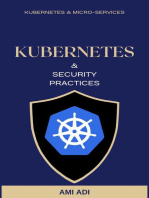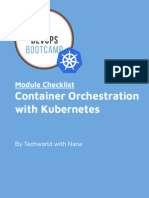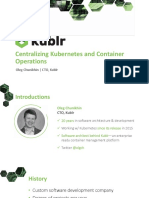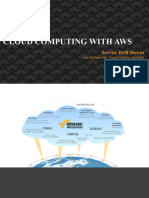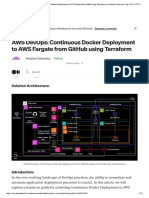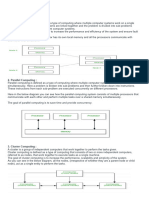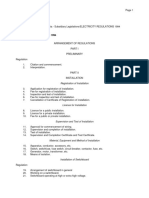(Whitepaper) How To Build Enterprise Kubernetes Strategy
Uploaded by
Mars Wang(Whitepaper) How To Build Enterprise Kubernetes Strategy
Uploaded by
Mars WangBusiness Whitepaper January 2023
How To Build An
Enterprise Kubernetes
Strategy
A Definitive Guide For Business Leaders
Contents
Introduction .......................................................................................................................................................................................................3
The Danger of Too Many Good Things.............................................................................................................................................4
Understanding Your Organization’s Current Kubernetes Adoption............................................................................5
Where Will You Be Running Kubernetes Over The Next Five Years?.............................................................................7
Who Should Own the Kubernetes Strategy?................................................................................................................................8
Centralized vs Decentralized Kubernetes Management....................................................................................................9
Containerization and Kubernetes Will Disrupt Some of Your Other Plans..............................................................10
Preparing Your Teams for Broader Kubernetes Adoption..................................................................................................13
Evaluating Enterprise Container Management Platforms.................................................................................................14
A Few Final Thoughts....................................................................................................................................................................................18
Appendix – Case Studies..........................................................................................................................................................................20
2 How to Build An Enterprise Kubernetes Strategy rancher.com
Introduction In today’s emerging cloud
native environments,
Organizations love Kubernetes because it
helps significantly increase the agility and
Kubernetes is everywhere.
efficiency of their software development
teams, enabling them to reduce the time and
perils associated with putting new software
into production. Information technology
operations teams love Kubernetes because it helps boost productivity, reduce costs and risks,
and moves organizations closer to achieving their hybrid cloud goals.
Simply put, Kubernetes makes it easier to manage software complexity. As enterprise
applications become more complex, development and operations (DevOps) teams need
a tool that can orchestrate that complexity. They need a way to launch all the services
dependent on these applications, making sure the applications and services are healthy and
can connect to one another.
Containers have dramatically risen in popularity because they provide a consistent way to
package application components and their dependencies into a single object that can run in
any environment. By packaging code and its dependencies into containers, a development
team can use standardized units of code as consistent building blocks. The container will run
the same way in any environment and can start and terminate quickly, allowing applications
to scale to any size.
In fact, development teams are using containers to package entire applications and move
them to the cloud without the need to make any code changes. Additionally, containers
make it easier to build workflows for applications that run between on-premises and cloud
environments, enabling the smooth operation of almost any hybrid environment.
3 How to Build An Enterprise Kubernetes Strategy rancher.com
The Danger of Too Many Good Things
The problem is that as more containers are deployed throughout organizations and in the
cloud, operations teams need a way to keep track of them. Otherwise, it quickly becomes too
much of a good thing becoming a bad, or at least an unmanageable, situation. That’s where
orchestration comes into play.
Kubernetes is an open source container orchestration platform that allows large numbers of
containers to work together in harmony and reduces operational burdens. In fact, Kubernetes,
originally developed by Google and now managed by the Cloud Native Computing
Foundation (CNCF), has become the standard for cloud container orchestration, providing a
platform for automating deployment, scaling and operations of application containers across
multiple clusters of hosts.
Kubernetes has moved from development and testing to production environments in many
enterprises. According to the CNCF Survey 2020, 83 percent of the respondents are running
Kubernetes in production, up from 78% in 2019. There has also been a 50% increase in the use
of all CNCF projects in just one year.
4 How to Build An Enterprise Kubernetes Strategy rancher.com
There is also an emerging ecosystem growing around Kubernetes as it expands within
enterprises. DevOps teams can leverage the incredible tooling that is coming out of the open
source software movement, such as new databases, big data tools, artificial intelligence, data
analytics, search and many others.
Clearly, Kubernetes is not a flash in the pan — it is here to stay — and its prevalence is likely to
expand dramatically as software complexity moves to more and more parts of the enterprise.
Understanding Your Organization’s
Current Kubernetes Adoption
Building an enterprise Kubernetes strategy starts with understanding where Kubernetes is
running in your organization and imagining how it’s going to change over the next decade.
Over the last several years, accessing Kubernetes has become much easier. Open source
tools make provisioning and upgrading a Kubernetes cluster (a set of nodes that run a
containerized application) quick and easy. Cloud providers are now offering Kubernetes as a
hosted service. Any team using Amazon Web Services (AWS), Google Cloud Platform (GCP), or
Microsoft Azure can provision a Kubernetes cluster in minutes using their popular EKS, GKE, and
AKS services respectively.
Self-managed K8S Hosted K8S
KubeADM Google GKE
Kops Amazon EKS
Kubespray Azure AKS
Rancher RKE Oracle OKE
K3s Digital Ocean
Hand-built Many, many more
5 How to Build An Enterprise Kubernetes Strategy rancher.com
It isn’t uncommon for organizations today to approach Kubernetes in the same way they
built OpenStack or other shared, centralized services. Teams can use Kubernetes to build
large clusters of infrastructure and then offer development teams shared access to those
clusters through Kubernetes namespaces. Using namespaces makes it possible for a cluster
administrator to segment cluster resources and define usage quotas and resource limits to
deliver a reasonably well isolated experience for each team that needs access to Kubernetes.
Other organizations have left it to individual departments or DevOps teams to decide for
themselves how and where to use Kubernetes. In these organizations, it isn’t uncommon to
have dozens of clusters deployed across public clouds and company data centers. Over
time, it is possible for tension to develop between individual teams wanting to run Kubernetes
in exactly the way they need it, and an IT organization that wants to maintain security and
control over how Kubernetes gets implemented.
The incentive for the development teams is flexibility: having cluster-level administrative
control allows them to configure the cluster to run exactly how they need it in terms of storage,
security policy or which infrastructure it runs on. IT teams are especially nervous about clusters
that are deployed and left unpatched and unmanaged. They would like to centralize the
operations and policy around clusters and provide access to teams who need it.
If Kubernetes and containers are going to become the primary platform for running
applications across any infrastructure, IT managers must collaborate with DevOps to develop
a plan and a strategy for Kubernetes that satisfies the needs of the development organization,
and meets IT’s own needs, as well.
As you document and understand where Kubernetes is running in your enterprise, be on the
lookout for individuals who show existing expertise in containerization. As you progress in
building your strategy, developing a team of experts who can administer your Kubernetes
clusters and deploy applications to them will be critical to driving adoption.
6 How to Build An Enterprise Kubernetes Strategy rancher.com
Where Will You Be Running Kubernetes
Over The Next Five Years?
Building an organization-wide Kubernetes strategy means prioritizing your goals for this new
technology.
If your team sets out to use Kubernetes to reduce infrastructure costs, you’ll probably focus on
building big clusters and trying to get as much density as possible out of them.
If your team focuses instead on using Kubernetes to accelerate innovation, you’ll take a
different approach, emphasizing flexibility and delivering more tooling around Kubernetes,
such as monitoring and CI/CD integration.
To prioritize your goals, try to understand the potential of Kubernetes, and imagine how your
organization may be using it in the future.
During the next five years, for example, you may use Kubernetes to do any of the following:
— Create microservice-centric applications. Kubernetes is a great way to run modern,
microservice-centric applications. It offers a rich set of functionalities that allow teams to
determine how different services within modern applications are run, handle unexpected
events, connect with each other, and connect with other applications and application
programming interfaces (APIs).
— Rapidly deploy Kubernetes clusters. Today, every major cloud provider has made it
easy to deploy Kubernetes clusters within minutes. Teams are continuously building
new applications, deploying them to different clouds, and using Kubernetes to run them.
Between clusters used for development, staging, and production, and the need to deploy
Kubernetes clusters across different data centers and cloud providers, it isn’t hard to
imagine that even the most well-organized company is still running dozens of Kubernetes
clusters.
— Move onto the edge. The same modern application architectures that we think of as cloud
native are now beginning to move out of the data center. Teams building software for
factories, hospitals, and stores now want to run applications with rich data analytics and
complex architectures as close to their customers and production facilities as possible.
Running applications this way is referred to as “running on the edge.”
7 How to Build An Enterprise Kubernetes Strategy rancher.com
— Develop for single-node devices. Even single-node devices such as point-of-sale
terminals, outdoor advertising, medical devices, 5G-enabled communication equipment,
security cameras, or automobiles now benefit from the ability to deploy and run
applications easily using microservices. We’re witnessing the sprawl of tens of thousands
of edge deployments, all running as individual Kubernetes clusters, and presenting an API
that needs to be managed.
Between clusters running in different clouds, data centers, and the edge, it’s almost certain that
your organization will be running more than one Kubernetes cluster. Unless you know you’ll only
be running a single application in one location, it probably makes sense to build your Kubernetes
strategy with an expectation that you’ll need to be able to easily provision and manage multiple
Kubernetes clusters running in many different places.
New technologies like Kubernetes are exciting to work with and it isn’t uncommon for many teams
to try to take ownership of building a containerization and Kubernetes strategy for their company. It
isn’t uncommon for individual DevOps teams, shared services groups, central IT, cloud platform or
platform-as-a-service (PaaS) groups to feel that they should be responsible for building a strategy
around Kubernetes.
Who Should Own the Kubernetes Strategy?
As always, there isn’t one correct answer for determining the team who should own your strategy.
Successful teams often bring together talent from across the organization and collaborate to
determine requirements. Still, investing in a strategy and building a platform means finding budget,
so it is most common that one team takes the lead on delivering on the strategy.
Two teams that often lead the Kubernetes strategy are the shared services team (responsible for
supporting developers and DevOps) and the central IT team (responsible for computing platforms).
Putting either team in charge of Kubernetes strategy provides the following benefits:
— Shared Services: The shared services team brings key insights on how an organization is
modernizing its approach to application development, as well as the requirements teams have
identified they need in a Kubernetes platform. They often understand other key systems that
have been built for DevOps, such as continuous integration/continuous delivery (CI/CD) tools,
development environments, data services, and application monitoring tools. Whether these
8 How to Build An Enterprise Kubernetes Strategy rancher.com
teams own the strategy or simply contribute to it, they represent at the very least one of
the primary consumers of containers in the organization. They should be a critical part of
developing your organization’s strategy.
— Central IT: The central IT team, focused on cloud computing and other computing
platforms, is also a logical team to lead a Kubernetes strategy. They have a strong
understanding of platform operations, infrastructure, security, multi-tenancy, and existing
IT investments, and they usually have significant experience running critical projects. A
project led by the IT platforms team will benefit from their understanding of the broad
requirements of many different teams across a large, complex organization. Note that
projects coming out of central IT often suffer from too little engagement with end users and
too much influence from existing technology vendors. These teams often have very little
experience with the latest application architectures and benefit enormously from working
closely with teams leading innovation around application development.
Centralized vs Decentralized Kubernetes
Management
Regardless of who owns your strategy, one of the critical questions that will emerge is how
much standardization is possible without impacting innovation. Many teams will have
experienced projects around OpenStack and PaaS that struggled to get adoption because
users weren’t able to get enough flexibility to deploy the next-generation applications they
were building.
With Kubernetes, there is enough flexibility in the platform and the ecosystem to satisfy any
team. Exposing that flexibility is critical to delivering value. Any strategy that abstracts away
Kubernetes will probably face resistance from your most innovative teams. At the same time,
the flexibility of Kubernetes and its ecosystem can be a hindrance to some teams looking for a
platform to just run standard apps.
One of the most exciting developments in the Kubernetes space in the past few years has
been the emergence of lightweight projects that run on Kubernetes but provide frameworks
that simplify application management. These approaches allow containers to “scale to zero”
and provide simple declarative languages to build, connect, scale, and monitor services. They
9 How to Build An Enterprise Kubernetes Strategy rancher.com
can deliver a powerful experience without requiring a deep understanding of the underlying
technology, which can benefit teams using CI/CD and stateless applications. SUSE’s Epinio
project (https://epinio.io/) is an example of this approach to running containers that simplify
some of the complexity of Kubernetes.
As you build your Kubernetes strategy, consider blending the best of a decentralized approach
with enough controls and management to ensure compliance and remove repetitive
tasks. Try to centralize and automate everyday tasks such as Kubernetes cluster lifecycle
management, role-based access control (RBAC) policies, infrastructure management, and
other day-2 operations. At the same time, give your teams options for where they can get
access to Kubernetes clusters and whether they can use a shared cluster or a dedicated
cluster. Focus primarily on maintaining visibility into all the provisioned clusters, not necessarily
forcing teams to use a set of preapproved clusters in a specified way.
Containerization and Kubernetes Will
Disrupt Some of Your Other Plans
If your organization has decided to expand the adoption of containers, Kubernetes will
accelerate innovation and become critical to your IT strategy. It’s also important to consider
how Kubernetes will impact other projects that are already happening. Below, we’ll look at a
few common projects that Kubernetes might affect. This is by no means an exhaustive list. Be
sure to consider your own organization’s existing projects and how your container strategy
might augment or impact them.
Our Organization is Heavily Investing in Cloud Computing
For organizations that are focusing on a “cloud-first” IT strategy, Kubernetes adoption will
almost certainly be part of a larger cloud strategy. Every large cloud provider offers hosted
Kubernetes clusters and often other types of container-oriented services such as registries,
monitoring, CI/CD and platform services. A key question for these organizations is whether
they should build a strategy for Kubernetes independent of the cloud computing strategy. If
an organization has chosen to commit to one cloud provider, it is likely they will defer to their
cloud provider’s strategy around containers. For example, if an organization runs or plans to
run most of their critical applications in Azure, it will make a lot of sense for them to have a
deep familiarity with the different containerization services in Azure. Obviously, they may find
10 How to Build An Enterprise Kubernetes Strategy rancher.com
that these services don’t meet their needs for some reason, but even if they implement their
own Kubernetes in Azure, they will want to implement it in a way that takes advantage of other
Azure services.
On the other hand, if an organization has decided to focus on multi-cloud as a strategic
initiative, it is likely that they will see Kubernetes as an opportunity to unify how they interact
with all their cloud providers. There are two competing theories for the best way to build a
multi-cloud strategy on Kubernetes:
— The first suggests that you should use the cloud providers only for core infrastructure
provisioning, and build a consistent platform based on Kubernetes on top of this
infrastructure. With this approach, teams would develop a consistent implementation of
Kubernetes and any of its dependent services, and then build a common platform on top
of the cloud infrastructure. This approach aims to minimize cloud lock-in and achieve
broad application portability. These teams will try not to use any of the proprietary services
that different cloud providers offer, instead opting for open source or multi-cloud solutions.
The large platform software companies often recommend this approach, suggesting that
using their PaaS platforms across different clouds can alleviate cloud lock-in.
— The second approach suggests that teams standardize policy and management around
Kubernetes, but assume that wherever they run Kubernetes, their developers will probably
want to use other services that might be unique to that computing environment. This
approach suggests that if you are running Kubernetes in AWS, you shouldn’t hesitate to
use other services that might be unique to AWS. These teams worry less about lock-in and
more about giving application teams the flexibility to use the native capabilities of different
platforms. With this approach, the focus needs to be on providing common management
and tooling around different implementations of Kubernetes.
We Are Investing in Hyper-Converged Infrastructure as Part
of a Data Center Upgrade
For teams that are building new data center capacity using hyper-converged infrastructure,
Kubernetes will almost certainly be a workload on these platforms. Deploying and operating
Kubernetes on hyper-converged infrastructure isn’t any more complicated than running
it anywhere else. However, you may find that the hyper-converged infrastructure provider
offers a Kubernetes implementation as part of their platform. With these services, integrating
11 How to Build An Enterprise Kubernetes Strategy rancher.com
them into a larger Kubernetes strategy could offer additional value. Alternatively, because
most hyper-converged infrastructure platforms offer APIs for provisioning of hosts or VMs, it
might make sense to incorporate the control plane into your Kubernetes management layer,
to enable auto-scaling of infrastructure as cluster sizes go up and down. If you’ve chosen
this route, a good place to start is SUSE’s cloud native HCI solution, Harvester. As open source
software, Harvester is free to download and deploy as well as integrating seamlessly with the
company’s multi-cluster management platform, Rancher Prime (More of this shortly).
Storage is another area where integrating with hyper-converged infrastructure can add a
lot of value. Many of these platforms have Kubernetes drivers that simplify volume creation
and can provide additional value around backup and recovery of stateful workloads running
on your Kubernetes platform. An excellent persistent block storage solution to investigate is
Longhorn. First developed at Rancher Labs (now part of SUSE), Longhorn is 100% open source
software whose development is now governed by the CNCF.
We Are Trying To Modernize Our Existing Applications To
Improve Security And Stability
A while back, a customer shared that they had more than 5,000 existing applications that they
were responsible for delivering and thought containerization and Kubernetes might be a good
solution for improving how they manage these applications. If you are building a Kubernetes
strategy, at some point, you will need to decide how your strategy applies to existing, legacy
workloads. Most of these applications are stateful, with loads of complex dependencies and
hard coded connections to other services. They don’t look like the cloud native applications
that Kubernetes was built for, and yet it is certainly possible to containerize them and run them
on a Kubernetes cluster. A recommended option is that teams postpone diving too deeply into
legacy applications until they have already been using Kubernetes for new workloads.
When your familiarity with Kubernetes expands and your team can manage multiple
production clusters running stateless, cloud native applications, that is a good time to start
looking at running legacy applications in containers. An entire paper could be written on best-
practices for migrating legacy applications to Kubernetes, but the bottom line is that it almost
always makes sense to run these applications in dedicated clusters with different approaches
to infrastructure management. These applications are architected with an expectation of
stability and infrequent failure scenarios. You can mimic that in Kubernetes and still get a
lot of the other benefits Kubernetes offers, such as consistent security, support of the latest
operating systems, advanced automation, and great monitoring and visibility.
12 How to Build An Enterprise Kubernetes Strategy rancher.com
We Need to Cut Our Infrastructure/Cloud Spending
If your organization is actively trying to cut costs, the potential of using Kubernetes to improve
density can be appealing. Kubernetes clusters offer multi-tenancy, and it isn’t unreasonable to
expect that you can get more bang for your infrastructure spend using containers and better
resource scheduling.
However, try not to orient too much of your business case for containerization toward cost
savings. Most organizations will take years to migrate a significant portion of their existing
application footprint to containers and Kubernetes.
Most of this time will be spent figuring out the right strategy for each application, specifically
whether to replace, rearchitect or just migrate it. Kubernetes certainly can help you get great
infrastructure utilization, but it will take time, and the strategy you are developing now is more
likely to impact your organization by enabling rapid innovation than by cutting infrastructure
spend.
Preparing Your Teams for Broader
Kubernetes Adoption
A critical part of any Kubernetes strategy is determining how you’ll train your teams to
leverage Kubernetes. As we mention earlier, if you find that your enterprise already has some
staff members with expertise in containers or Kubernetes, consider how you can incorporate
them into your initiative. This doesn’t mean necessarily pulling them off their existing work,
but perhaps they can work as part of the team setting requirements, evaluating tools, or
developing policies.
Regardless of your team’s skill level, you’ll almost certainly have team members who need
to be trained on either using or administering Kubernetes. Luckily, there is no shortage of free
Kubernetes training providers and online courses including the SUSE+Rancher Community
Academy – visit https://community.suse.com/all-courses
As you build your core team of early Kubernetes admins and users, consider setting a goal to
train and certify as many members of your team as possible. The tests are rigorous and help
you ensure that you build strong internal knowledge about using containers and Kubernetes.
13 How to Build An Enterprise Kubernetes Strategy rancher.com
For more information on SUSE’s training services visit https://training.suse.com/
After you have some initial expertise, you may want to wait to do further training until you’re
out of the design phase of your strategy and bringing on more teams to work with the specific
implementations of Kubernetes your organization is adopting. At this stage, SUSE provides
an array of different consulting services which can help you mitigate the risks associated
with large, production grade deployments. For more information visit https://www.suse.com/
services/
Evaluating Enterprise Container
Management Platforms
Up until now, we have talked about building an enterprise Kubernetes strategy based on
understanding how your DevOps teams will be using Kubernetes over the next few years and
orienting your platform to support these teams. We have talked about the importance of
maintaining flexibility while still providing centralized controls and management. At this point,
teams begin to investigate technical options for managing containers across the organization.
Some analyst firms describe this class of software as Enterprise Container Management (ECM)
software and is a term used to describe tools like RedHat OpenShift, VMware Tanzu, Google
Anthos and Rancher Prime. While we don’t want to spend too much time in this document
comparing these different offerings, we do want to highlight some capabilities you should be
considering when determining how they can help you implement your Kubernetes strategy.
Kubernetes Distribution, Cluster Provisioning and Lifecycle
Management
Most ECM products will include a standard Kubernetes distribution and should be able to
provision a cluster and support your team in upgrading it to the latest version of Kubernetes.
Some will also include integrated monitoring, etcd backup and recovery and infrastructure
provisioning and auto-scaling. If you will be using a Kubernetes distribution provided by your
ECM vendor, it is important that the distribution you use is certified by the CNCF. This will ensure
that it is consistent with upstream Kubernetes and quickly supports the latest features being
developed in the community.
14 How to Build An Enterprise Kubernetes Strategy rancher.com
Multi-Cluster Kubernetes Management
If you expect to manage multiple Kubernetes clusters at the time of launch or in the future, it
is worth reviewing how an ECM approaches multi-cluster management. Look at how the ECM
manages multiple clusters and whether it can manage different types of clusters including
cloud-based Kubernetes services. Does the platform only manage clusters it deploys,
or can you import existing clusters that may already exist? Most importantly, what does
“management” of these different clusters mean? What type of actions can you take across
these different applications?
Visibility is great, but you will also want to implement policy and controls, automate
operations, provide application catalogs, and possibly offer other shared services. If multi-
cluster management is key to your strategy, be sure that you understand what it means and
how different ECM platforms implement it.
User Management and Delegated Administration
The core purpose of any Kubernetes platform is to provide a shared service to your users that
makes it easy for them to innovate. Your evaluation of ECM tools should be oriented toward
understanding how you will manage many users and the experience you can deliver to them.
Understanding the user journey starts with defining how users will access Kubernetes. Ensure
your platform supports your existing single sign-on service such as LDAP or Microsoft Active
Directory. You’ll want the ability to authorize both individuals and teams to access specific
clusters or name spaces, and the ability to define a wide variety of roles that fit your business
requirements.
Once you have ensured your platform supports the necessary access control capabilities,
consider what administrative capabilities you can delegate to team leads, cluster owners,
and project owners. Does the platform allow you to dedicate resources to specific teams?
Can you easily define resource quotas and manage utilization of shared platforms? Can
teams collaborate on projects and share application catalogs? However, you decide to deliver
Kubernetes to these different teams, be sure you are providing direct access to the Kubernetes
API and kubectl, as this will ensure they can access all of the features of Kubernetes.
15 How to Build An Enterprise Kubernetes Strategy rancher.com
Policy Management
Building a central policy management layer lets you ensure compliance and adequate
controls across all your organization’s implementations of Kubernetes. Most ECMs will
have administrator control planes that allow your teams to define policies and apply
them to all the teams using Kubernetes and all the clusters in the organization.
For example, the Kubernetes Pod Security Policy is a cluster-level resource that controls
security sensitive aspects of the pod specification. The Pod Security Policy objects
define a set of conditions that a pod must run with to be accepted into the system, as
well as defaults for the related fields. They allow an administrator to control functions
such as running of privileged containers, usage of host namespaces and usage of
host networking and ports, to name a few. Policy management can also address
container image scanning, cluster configuration and even application deployment. For
instance, if your organization decides to implement a container security product, policy
management should allow you to ensure that these applications are automatically
installed on any new or imported Kubernetes cluster.
User Experience and the Entire Cloud Native Stack
Kubernetes is a powerful engine, with a rich ecosystem of tools around it. Most ECM
platforms will provide a full user experience around Kubernetes that incorporates
ecosystem tools and delivers a user interface to simplify workload management. As you
evaluate these platforms, consider how they have approached integrating adjacent
technologies, such as the container engine, overlay networking, automation tooling,
container registries, service mesh, monitoring, logging, CI/CD and application catalogs.
Are these tools tightly or loosely coupled with the platform, and how does that impact
the flexibility your teams will have to implement new approaches as they develop?
One of the biggest risks of an ECM is that it puts too much emphasis on integrated
solutions and ease of use and ends up limiting flexibility. Kubernetes is well architected
for plug-and-play integration with most of its ecosystem, so be sure not to lose that
flexibility. For example, if a platform offers an integrated CI/CD, make sure that your
teams that already have CI/CD tooling can easily connect their existing process to it
as well.
16 How to Build An Enterprise Kubernetes Strategy rancher.com
Rancher Prime Integrations – SLA Coverage & Certified Integrations
Kubernetes Security and Audit
As you consider ECM tools, it is critical that you collaborate with your security experts and
ensure the tools will support your broader security requirements. Most ECM offerings address
security and auditing at a global level and can provide you with a good understanding of their
approach. At the platform level, some of the most important capabilities to consider include
role-based access control, centralized security policies, container image scanning and the
ability to quickly patch Kubernetes and the container runtime (Docker, containerd or CRI-O).
Some platforms such as Rancher Prime will even assess your clusters against CIS (Center for
Internet Security) benchmarks for Kubernetes security.
In addition to the platform-level security, there is a rich ecosystem of organizations that
focus on container security including SUSE’s NeuVector. Such tools provide different security
capabilities on top of the capabilities of Kubernetes or an ECM and are worth evaluating as
part of your broader implementation of Kubernetes.
17 How to Build An Enterprise Kubernetes Strategy rancher.com
Open Source, SaaS, and Support
If you decide to roll out an ECM, one of the key decisions you’ll have to make is how to operate
the platform. Most ECM tools today are delivered as software, and many, such as Rancher are
available for free as open source software. Because of this, it should be easy for your team to
deploy and evaluate multiple technologies in this space. All of the open source tools offer an
option for enterprise-grade support. As you’re looking at these options, consider whether that
support requires you to move from the open source version to an “enterprise edition” that may
add features, but can also make it difficult to move back to the open source version later if you
don’t want to pay any more. When you’re evaluating the support offered by these ECM tools,
consider how much of the stack is supported. Are you getting support for Kubernetes? What
about the container runtime, service mesh, networking implementation and other cloud native
stack components, such as Istio, Prometheus and Helm? Does the vendor provide root-cause
analysis across all these elements of the stack?
If you don’t want to operate one of these platforms yourself, some vendors offer cloud-based
or managed versions of these ECMs. If you decide to move to a hosted ECM, consider how
much flexibility you’ll have in the future to move off it as your needs change. Is it a shared
implementation of the ECM or is it dedicated to your organization? You’re going to build lots
of policies, templates, best practices, and integrations with an ECM, so make sure that there is
some way for you to extract that logic and move it to a different platform if your requirements
change in the future.
A Few Final Thoughts
Adopting a new technology across a large organization is never easy. As technologists, we
get excited when new approaches emerge that have the potential to create new, amazing
experiences for our customers. Many of us who have been working in technology for the last 20
years see Kubernetes and containerization as the third phase in a process that started with the
emergence of virtualization and expanded with cloud computing. As you build an enterprise
containerization strategy, be sure to learn from your organization’s past successes and failures
in adopting these other technologies. If you have team members who were instrumental in
rolling out VMware or AWS in your organization, incorporate them into this project and see what
insights they can provide that are specific to your organization.
18 How to Build An Enterprise Kubernetes Strategy rancher.com
We talked earlier about how to determine who should lead any enterprise-wide strategy
around containers. As you develop and implement your Kubernetes strategy, pay special
attention to the teams who are already running apps on Kubernetes. Each of these teams
should be represented on your strategy team and should be validating that your approach
to managing Kubernetes will not introduce constraints that would keep them from adopting
it. Focusing on the early adopters will help you avoid over-simplification and delivering a
platform that deviates from mainstream Kubernetes adoption.
As you set off on this journey, pay special attention to learning from other organizations that
are adopting Kubernetes. Every year, the presentations from KubeCon are recorded and
posted to YouTube. You can find a wealth of real-world advice from teams who have gone
through rolling out Kubernetes at either a project or company-wide level.
19 How to Build An Enterprise Kubernetes Strategy rancher.com
Appendix – Case Studies
STFC: Using Kubernetes to better understand climate
change
Highlights
— Supports STFC’s unique needs
— Supports unique needs of global research community
— Easy-to-use, and has hands-on support
— Interoperable: flexibility to build, scale and transform on demand
— Enhances the ability to deploy, manage and scale services JASMIN offers to the user
community
Products
Rancher Prime
What is STFC?
On behalf of the UK scientific community, STFC is tasked with running national laboratories and
conducting research into major science projects with large-scale infrastructure and resource
requirements. STFC has a broad remit. It provides bespoke technology and resources for
hundreds of research projects, covering a wide range of different science areas. Its UK-based
teams are involved in high-profile projects, and JASMIN is run in partnership between the
CEDA, part of STFC’s Rutherford Appleton Library (RAL) Space department, and STFC’s Scientific
Computing Department. No matter the variety and scale of each project, JASMIN has a clear
mission — to provide scalable compute environments that help researchers find meaningful
answers to the big scientific questions in the environmental sciences domain.
20 How to Build An Enterprise Kubernetes Strategy rancher.com
Advancing data science for the global good
Amongst the host of research projects STFC’s compute resources support, a growing number
of teams are focused on pushing boundaries in climate science. The JASMIN Notebooks
Service has become a useful tool to support data
analytics in environmental sciences research. Later, “The team at STFC were
we’ll explore an example from a Ph.D. student working looking for a vendor-backed
with STFC’s JASMIN platform to better understand rising solution to help manage its
inner-city temperatures. Kubernetes estate. Working
with Rancher Prime, the
Over the years, Jupyter Notebooks have become a Kubernetes architecture was
familiar way for academics to consolidate and analyze easy to deploy, manage and
volume data. A Jupyter Notebook is an interactive scale.”
document containing live code and visualizations, Sheng Liang
viewed and modified in a web browser. The JASMIN Former President of Engineering
Notebook Service, based on the open source and Innovation, SUSE
JupyterHub, provides the ability to run multiple Jupyter
Notebook sessions via one easily accessible platform
served over the web.
Part supercomputer, part cloud, STFC’s JASMIN platform was the backbone of a recent COP26
hackathon, which saw over 150 attendees exploring topics ranging from climate change to
oceanography and biogeochemistry. JASMIN gave attendees — even those with no prior
coding experience — easy access to Jupyter Notebooks via web browser where they could
interact with terabytes of data.
Ease of use is particularly critical when managing the complexities of climate data at scale.
STFC’s JASMIN platform allows the processing and analysis of massive data sets, from
multiple origins and in myriads of formats. By co-locating these data alongside services like
Jupyter, JASMIN gives user more control by removing issues around data movement and
data wrangling to allow them to get insights more quickly. While STFC’s JASMIN platform is the
secret to potentially world-changing research projects, Kubernetes, underpinned by Rancher
Prime, provides the underlying infrastructure for the Notebook Service.
Kubernetes to the core
STFC’s JASMIN Notebook Service was built on Kubernetes containers from the ground up.
JASMIN currently serves more than 1500 researchers, exploring a vast range of topics.
With climate change high on the agenda for governments everywhere, climate-related
21 How to Build An Enterprise Kubernetes Strategy rancher.com
projects have never been more important. From oceanography to air pollution, earthquake
deformation and analysis of wildlife populations, JASMIN is being put to clever use in
environmental science.
To fulfil the need to reduce latency and enable real-time analysis, STFC opted for a bare-
metal cluster deployment from Rancher Prime. Once configured with STFC’s storage
capabilities, this allowed researchers access to petabytes of data in real time — impossible in
a standard desktop environment.
Overcoming operational challenges
Scale, flexibility and open interoperability
In recognition of the growing demand for hyperscale compute resources, STFC wanted to build
greater scale and agility into its Kubernetes estate. Rancher Prime allows technology teams
to flex compute resources faster, making the service resilient for the long term, no matter how
complex or varied projects may be.
Secondly, another key factor for STFC was interoperability; not only does the organization
combine its bare-metal setup with data hosted in the cloud, users are also turning to the
JASMIN Notebook Service for a widening range of use cases. Kubernetes and Rancher Prime
offers those users the freedom to choose what best suits diverse needs, and the flexibility to
build, scale and transform on demand.
Sheng Liang, former president of engineering and innovation at SUSE says: “The team at STFC
were looking for a vendor-backed solution to help manage its Kubernetes estate. Working with
Rancher Prime, the Kubernetes architecture was easy to deploy, manage and scale.”
Case Study: Sarah Berk Ph.D.: Exploring the Heat Island Effect in Inner Cities
Sarah Berk is a Ph.D. student at the University of East Anglia (UEA) who uses STFC’s JASMIN
Notebook Service to analyze terabytes of data measuring heat from cities all over the world.
She’s exploring the urban heat island effect; a phenomenon in which metropolitan areas are
significantly warmer than surrounding rural areas due to human activity and properties of the
urban environment.
“It’s a really important area for two key reasons,” says Berk. “The first is migration. Now, over
half the world’s population live in cities, and that will grow to 68% by 2050. The second factor
is this backdrop of a changing climate, particularly increasing global temperatures and an
increasing frequency of heatwaves.”
22 How to Build An Enterprise Kubernetes Strategy rancher.com
Berk believes this research will help us understand the relationship between increasing city
temperatures and global shifts in climate. Eventually, she hopes it will provide a framework
for change in metropolitan planning and design — whether that’s the selection of building
materials or the creation of new green spaces.
Berk, who learnt a new programming language for this project, says that JASMIN enabled her
to hit the ground running without having to learn a lot of new skills. It allows her to visualize and
analyze huge amounts of data at a speed that otherwise wouldn’t be possible. She’s currently
working with two datasets — land surface temperature and land use data.
Berk explains: “Because I am using 15 years’ worth of data spanning the entire globe in
300-meter resolutions, the sheer volume of data processing is immense. It’s not possible to
use my laptop to analyze this, which is why I use STFC’s JASMIN Notebook Service.
“At UEA there is a High-Performance Computing Environment for supporting intensive
computing, but the data I’m working with is too big to store on that, so I’m storing it on an
external hard drive,” Berk adds. “As such, it’s a lot easier to have that data already stored on
JASMIN and not have to worry about it — nor have to go through the time-consuming task of
downloading it.”
What’s next?
Since JASMIN was first launched in early 2012, it has grown significantly in scale and complexity
but also in the variety of projects it serves. This growth is likely to continue as the world
increasingly turns to the research community to find innovative ways to combat the climate
crisis.
23 How to Build An Enterprise Kubernetes Strategy rancher.com
Hypergiant: Putting Managed Compute
Power In Space With K3s
Highlights
— 80% reduction in deployment time compared to manual methodology — from weeks to
days
— World first: Kubernetes clusters in space for the first time
— Creating a long-term commercial future for space hardware
— K3s clusters created in minutes
— Simple remote update and patching
Products
Rancher Prime
K3s Lightweight Kubernetes
What is HyperGiant?
Hypergiant Industries focuses on solving humanity’s most challenging problems by delivering
best in class artificial intelligence solutions and products. The company creates emerging
AI-driven technologies for Fortune 500 and government clients working in a host of sectors,
including space science and exploration, satellite communications, aviation, defense, health
care, transportation and more.
Previously a ‘Cyber Transport Journeyman’ in the U.S. Air National Guard, Bren Briggs is used
to being deployed to the most hostile environments to design and run command and control
communications. Now responsible for DevOps and Cybersecurity at Hypergiant, Briggs draws
on his military background, bringing expertise in designing and building repeatable, secure
deployments of Kubernetes and other infrastructure to support Hypergiant’s AI and machine
learning (ML) applications and customers.
24 How to Build An Enterprise Kubernetes Strategy rancher.com
Briggs is one member of a wider team of experts working for the U.S. Department of Defense’s
official DevSecOps enterprise services platform, DOD PlatformONE. Briggs works alongside
SUSE’s RGS co-founder and Kubernetes Edge Architect Chris Nuber, and Hypergiant’s Space
Systems Architect Chris Tacke. Together, they are on
track to achieve the impossible in the most hostile
“There isn’t another version of
environment of all — putting K3s clusters to work in Kubernetes that can meet our
orbit on military satellites for the very first time. use case. K3s has allowed us
to build infrastructure suitable
The Journey to Kubernetes for use in space without the
Hypergiant and SUSE’s Rancher Government Solutions
need to create our own edge
distribution.”
(RGS) are working together with DOD PlatformONE to
demonstrate the benefits of DevSecOps, Kubernetes Bren Briggs, Director of DevOps and
and AI/ML apps in remote and often disconnected Cybersecurity, Hypergiant
environments. Working with K3s (recently accepted as
a CNCF Sandbox project), the team is developing and
integrating their software pipeline with the EdgeONE
and SatelliteONE missions, including the launch of Hypergiant’s Kubernetes-embedded
satellite planned for the first quarter of 2021.
Briggs started working with Kubernetes several years ago to solve the problem of managing
multiple Docker containers. At that time, containers were built and shipped like virtual
machines (VMs) — updated and managed in Puppet. With a growing need for consistency,
Kubernetes became an important way to reliably network the estate of containers and
manage them centrally.
In 2019, Briggs brought this experience to Hypergiant, where he noticed repetition in existing
development methods. He recognized the need for a platform that would allow developers
to deploy repeatable patterns with less manual effort. They needed a cloud that could run
anywhere, and so Briggs suggested Kubernetes to automate the creation of repeatable
workloads. In early 2020, the team started rolling out Kubernetes on several internal systems.
As they ran on AWS, EKS was initially deployed to orchestrate the first cluster, but soon, K3s
entered the team’s consciousness.
25 How to Build An Enterprise Kubernetes Strategy rancher.com
With a mandate to find a way to run Kubernetes in space, Briggs, Tacke and Nuber began
investigating. Briggs was impressed. K3s was designed as a lightweight, compact version
of Kubernetes that could run in remote, low-power, hostile environments. Available ‘off the
shelf,’ K3s was easy to install and avoided the need for Briggs and the team to ‘roll their own’
lightweight distribution. Crucially, Briggs estimates deploying a cluster takes just a day using
K3s, compared to weeks in a manual methodology. The cluster itself builds in 10 minutes using
Ansible plays. Provisioning base services takes another 30 minutes. Production can be ready
before launch once the automation has been written.
A World First: Putting Kubernetes Clusters in Orbit
The satellite industry faces several problems. Firstly, space-rated hardware is costly. Software
development and delivery processes are slow. And it’s cold — really cold. On-orbit satellite
software updates are often not possible or incredibly time-consuming and expensive. As a
result, AI/ML capabilities are far behind those currently available on earth.
Satellite connectivity and bandwidth are poor, which makes downloading large images and
other data difficult. The SatelliteONE mission has been designed to solve this problem. The
project will demonstrate DevSecOps in space by leveraging PlatformONE’s CI/CD pipeline
alongside Kubernetes provisioning and deployment. Importantly, it will evaluate the use of
lower-cost hardware on satellite payloads, show how the rapid delivery of software updates in
space can be done and demonstrate the use of AI/ML software in orbit.
The U.S. Department of Defense, along with governments worldwide, are looking for ways to
build longevity and sustainability into satellite fleets. They want to modernize their entire fleets
to be managed, maintained, and, crucially, reconfigured for various use cases for the long
term. This is a massive shift, but investment in modernization will create agile technology
stacks that can be more easily updated and replaced in the future.
Because K3s is packaged as a single <40MB binary, it reduces the dependencies and steps
needed to install, run and auto-update a production Kubernetes cluster. Supporting both
ARM64 and ARMv7, K3s works just as well on a Raspberry Pi as it does with an AWS a1.4xlarge
32GiB server. K3s is enabling Hypergiant to deploy the modern, lightweight software systems
that will drive the next evolution and commoditization of the satellite industry.
26 How to Build An Enterprise Kubernetes Strategy rancher.com
Deploying K3s to Achieve the Impossible
SatelliteONE’s initial mission is an important one—to take a picture of Baby Yoda. While this
doesn’t sound particularly ground-breaking, this exercise’s primary purpose is to demonstrate
the ability to capture images and perform AI and ML workloads at the edge.
This is an important milestone given the bandwidth constraints experienced in space. When
dealing with a link, measured in kilobits per second, only available for a few minutes at a time
during a flyover window, transfer efficiency is the ultimate goal. In this use case, the team
wants to transfer the minimum amount of information.
The architecture consists of two Raspberry Pi server nodes, independent of each other, with
one being a warm backup. There are two Raspberry Pi 4 worker nodes, each loaded with a Pi
camera, and another Raspberry Pi 4 with an accelerometer and light sensor. Finally, there is a
Jetson nano module (developed by NVIDIA), a $99 IOT AI processor mounted on the satellite
and used to capture and process the image of Baby Yoda.
The two master nodes have an additional ethernet adapter attached to another switch
and have connectivity to the Cygnus device and external network, allowing communication
with the ground (Cygnus is the vehicle the team is hitching a ride on courtesy of Northrop
Grumman). There are two independent K3s server nodes in place. This is critical should
one server device fail in orbit — the team can quickly communicate with the server node,
automatically failover, or run scripts to rebuild the cluster in a matter of minutes. Since the
clusters are logically separated, all the K3s images and the application workloads are stored
locally on each node—less overhead and one less point of failure.
Importantly, this is about sending analysis rather than the raw image itself. Ultimately, a
human can still make decisions as to which photos to downlink. However, the focus here is to
process decisions at the edge, sending analysis and results instead of the raw dataset.
The team is also conducting a temperature experiment to observe how the Jetson behaves
in a vacuum under a heavy computational load. Why, though, would the team put a
whole satellite in space to take a few pictures of Baby Yoda and conduct temperature
measurements?
27 How to Build An Enterprise Kubernetes Strategy rancher.com
By proving these basic processes work, the team can highlight the use case for Kubernetes in
orbit. Industries of all kinds that rely on satellite communications and imaging want to create
modern satellite fleets that can be used for longer and have less environmental impact.
By deploying novel compute technologies, like K3s on orbiting devices, their longevity and
ongoing usability are assured. Working with K3s, Hypergiant, SUSE’s RGS and DOD PlatformONE
are creating a commercial future for data processing in space.
28 How to Build An Enterprise Kubernetes Strategy rancher.com
Compare the market-leading
Kubernetes management
platforms including Rancher Prime
Forward thinking organizations are adopting platforms like Rancher
Prime to help streamline the deployment and management of their
Kubernetes clusters.
In this latest Buyer’s Guide, we compare Rancher Prime with the three
most competitive Kubernetes management platforms: Red Hat
OpenShift, VMware Tanzu, and Google Anthos.
DOWNLOAD THIS FREE GUIDE AT
29 SUSE.TO/BUYERSGUIDE
How to Build An Enterprise Kubernetes Strategy rancher.com
You might also like
- Kubernetes ATC Kube Ebook-Final Feb 2020 PDFNo ratings yetKubernetes ATC Kube Ebook-Final Feb 2020 PDF11 pages
- About Kubernetes and Security Practices - Short Edition: First Edition, #1From EverandAbout Kubernetes and Security Practices - Short Edition: First Edition, #1No ratings yet
- Mastering Kubernetes in Production: Managing Containerized ApplicationsFrom EverandMastering Kubernetes in Production: Managing Containerized ApplicationsNo ratings yet
- AWS Solution Architect Associate Agenda PDFNo ratings yetAWS Solution Architect Associate Agenda PDF6 pages
- Ultimate AWS Certified Solutions Architect Associate (SAA) UdemyNo ratings yetUltimate AWS Certified Solutions Architect Associate (SAA) Udemy10 pages
- Build and Run Applications in A Dockerless Kubernetes WorldNo ratings yetBuild and Run Applications in A Dockerless Kubernetes World49 pages
- Understanding Your Application Readiness When Migrating To AWSNo ratings yetUnderstanding Your Application Readiness When Migrating To AWS27 pages
- Centralizing Kubernetes and Container OperationsNo ratings yetCentralizing Kubernetes and Container Operations24 pages
- Getting Started With Docker: Improve Performance, Minimize CostNo ratings yetGetting Started With Docker: Improve Performance, Minimize Cost7 pages
- 15 Reasons To Use Redis As An Application Cache: Itamar HaberNo ratings yet15 Reasons To Use Redis As An Application Cache: Itamar Haber9 pages
- How To Design and Provision A Production-Ready EKS Cluster: Image Credit: PixabayNo ratings yetHow To Design and Provision A Production-Ready EKS Cluster: Image Credit: Pixabay11 pages
- Tapan Banker, Tapan Nayan Banker Cloud Architect, EnterpriseNo ratings yetTapan Banker, Tapan Nayan Banker Cloud Architect, Enterprise2 pages
- Migrating To Cloud-Native Architectures Using Microservices: An Experience ReportNo ratings yetMigrating To Cloud-Native Architectures Using Microservices: An Experience Report15 pages
- AWS Certified Developer Associate - Exam GuideNo ratings yetAWS Certified Developer Associate - Exam Guide16 pages
- ### AWS DevOps - Continuous Docker Deployment To AWS Fargate From GitHub Using Terraform - by Antoine Cichowicz - Sep, 2023 - AWS in Plain EnglishNo ratings yet### AWS DevOps - Continuous Docker Deployment To AWS Fargate From GitHub Using Terraform - by Antoine Cichowicz - Sep, 2023 - AWS in Plain English22 pages
- Azure Devops: Sato Naoki (Neo) - @satonaoki Jazug Tohoku Azure Devops #Jazug #AzuredevopsNo ratings yetAzure Devops: Sato Naoki (Neo) - @satonaoki Jazug Tohoku Azure Devops #Jazug #Azuredevops34 pages
- Serverless-Architectures-With-Aws-Lambda DocumentationNo ratings yetServerless-Architectures-With-Aws-Lambda Documentation50 pages
- Adding Observability To A Kubernetes Cluster Using Prometheus - by Martin Hodges - Jan, 2024 - MediumNo ratings yetAdding Observability To A Kubernetes Cluster Using Prometheus - by Martin Hodges - Jan, 2024 - Medium2 pages
- (External) FREE AWS Cloud Project Bootcamp - OutlineNo ratings yet(External) FREE AWS Cloud Project Bootcamp - Outline42 pages
- Kubernetes Cluster Using Terraform and AnsibleNo ratings yetKubernetes Cluster Using Terraform and Ansible48 pages
- A987059828 - 11266 - 4 - 2020 - GCp-3 My PDFNo ratings yetA987059828 - 11266 - 4 - 2020 - GCp-3 My PDF42 pages
- Software Development Company in CaliforniaNo ratings yetSoftware Development Company in California20 pages
- AWS Knowledge: AWS Certified Solutions Architect - Associate Level Exam BlueprintNo ratings yetAWS Knowledge: AWS Certified Solutions Architect - Associate Level Exam Blueprint3 pages
- Experimental Results On Adhesives For Mixed-Media Textile Art in Studio-Based PracticeNo ratings yetExperimental Results On Adhesives For Mixed-Media Textile Art in Studio-Based Practice8 pages
- Client/server Networks Are More Suitable For Larger Networks. A CentralNo ratings yetClient/server Networks Are More Suitable For Larger Networks. A Central5 pages
- Global MEPS Guide For Low Voltage Motors 50060049 Brochure EnglishNo ratings yetGlobal MEPS Guide For Low Voltage Motors 50060049 Brochure English12 pages
- Soviet Topographic Map Symbols-Sayfalar-2No ratings yetSoviet Topographic Map Symbols-Sayfalar-217 pages
- Management of Hazardous Waste in Malaysia - 194351No ratings yetManagement of Hazardous Waste in Malaysia - 1943515 pages
- Mitsubishi 6D22 Cylinder Head Rebuilding Information, Specifications and Parts PDFNo ratings yetMitsubishi 6D22 Cylinder Head Rebuilding Information, Specifications and Parts PDF11 pages
- Title: No More Than Four Lines: Article Type: Description (See Intro For More Detail)No ratings yetTitle: No More Than Four Lines: Article Type: Description (See Intro For More Detail)5 pages
- Axora Innovation Forecast 2022-23 FinalNo ratings yetAxora Innovation Forecast 2022-23 Final15 pages
- 2022-03 - UN - Impact of Russia Ukraine WarNo ratings yet2022-03 - UN - Impact of Russia Ukraine War9 pages
- Body Structure of the Mercedes Benz-W210 SeriesNo ratings yetBody Structure of the Mercedes Benz-W210 Series4 pages
- 2.7.4 Practice - Modeling_ Similarity Theorems (Practice) (1)No ratings yet2.7.4 Practice - Modeling_ Similarity Theorems (Practice) (1)4 pages
- Load Calculation: Self-Weight of Materials SL No Material Density (KN/M)No ratings yetLoad Calculation: Self-Weight of Materials SL No Material Density (KN/M)6 pages

